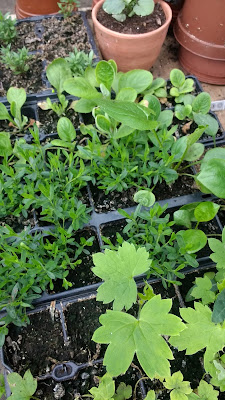Country Garden Herbs wide choice of mints
Perennials coming on well
Plug grown thyme
Pot grown thyme
The perennial bumper collection of 72 plants is doing very
well. I have had to re-pot a few
varieties of some faster growing plants like the gaura, delphiniums and verbena
into larger one litre pots and the others aren’t far behind.
I’m very happy with the impulse buy but still haven’t found
anywhere to put the plants once they mature. I did salvage a small plot of
ground where the broccoli was growing. It had gone from flower to seed and the
insect buzzing stopped so the time was just right to clear the ground. I built
a small raised bed on the fresh, weed free soil and have decided to create a
small creeping thyme area. I am hedging
my bets as usual and have acquired plants and seeds from different places. The first set of cuttings I got from a
neighbours garden, I then bought seeds from two different places to germinate,
I ordered mail delivered plug plants and then I went to a plant nursery in
Garvagh near Coleraine for the mature 9cm pot grown specimens.
It might sound a bit OTT to get plants from so many places
but it’s my irrepressible urge to not only grow the plants but to research and
view how well each batch does. Some growers say cuttings are not a good idea
and only go for seeds so we’ll see. I’ll probably bore you with the results
sometime next year.
The seeds have been sown, cuttings taken and plugs planted
in the raised bed. I was happy (ish)
with the plugs but they were a bit yellow on arrival but will soon pick up. The
9cm pot grown ones on the other hand were fabulous and well worth the trip into
the North coast countryside. I got them
from a bloke called Malachy who runs Country Garden Herbs in Garvagh. He specialises in growing all types of herbs
so when I got there it was like a sweetie shop for me. He has 12 different
types of mint so I couldn’t come away without getting a couple of varieties.
Malachy suggested I sniff the separate leaves and there were subtle differences
to the aroma. I bought three types,
chocolate, berry and cream and pineapple flavours. They are in pots on the
patio as I would guess they are all just as invasive as the more common types.
I came away from Country garden Herbs learning a lot and 12 beautiful
thyme plants. I planted 10 of them
straight out in my new planting space
and then took 360 cuttings from the last couple and put them in 3cm plug trays.
If only a few survive I’ll be happy and if loads of them grow you’ll see me at
the country market with a stall.
Microgreens
As well as growing the dizzying array of herbs in pots,
Malachy also spends his day delivering hydroponically grown Micro greens to
hotels and restaurants along the north coast. He can pick, pack and deliver the
fresh greens to discerning chefs within two hours of them being picked. He’s a
busy man who seems to take everything at a really relaxed pace and loves what
he does.
To give you an idea of the range of microgreens Malachy is
growing, he has 4 types of basil – including spice and cinnamon flavour,
coriander, celery, fennel, mustard, chervil, red cabbage, broccoli and spicy
mixed salad so the next time you are eating out on the North coast chances are
you’ll be tucking into some of Malachy’s freshly picked greens.
Mulch can damage
trees
If you plant a small tree, ties aren’t generally needed. In
fact research has shown (not mine) that a small tree without a tie will grow
far faster and healthier than a larger tree planted with a stake and tie
holding it in place. So when I see trees
all tied up where the bark is straining to expand because of the pressure of
the rubber, I generally adjust them so they can grow unhindered. – or take them
off all together.
All too often they are just forgotten about after planting.
There’s another issue for trees and that’s to much mulch around the base of the
trunk. Too much mulch applied over the
root ball or resting against the trunk can cause problems. Roots often grow up
and into the mulch causing stem ‘girdling’ roots. This is where the tree
doesn’t know where ground level is. The cover can also hide decay and dead
spots on the lower trunk and major roots. Decay in this portion of the tree can
cause the tree to become unstable. If you are mulching around trees then keep
mulch about 12 to 18 inches (30-45cm) from the trunk for any size of tree. If
you see someone kicking mulch from a tree trunk in your travels it’s probably
me.








